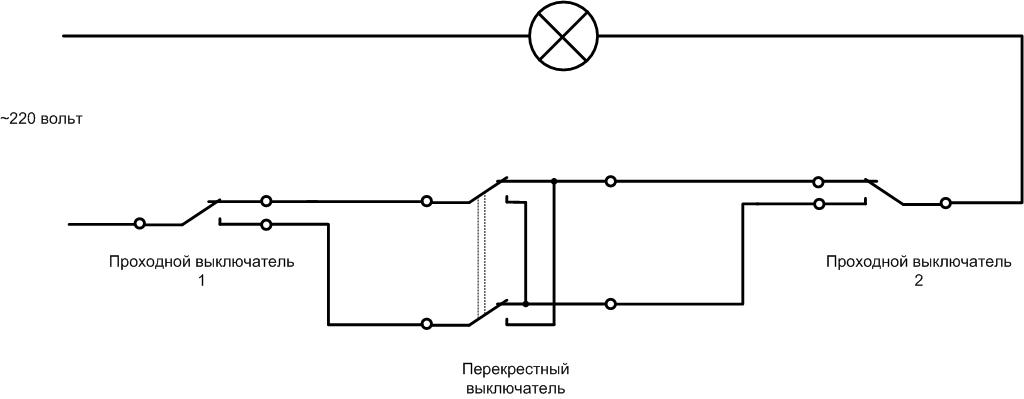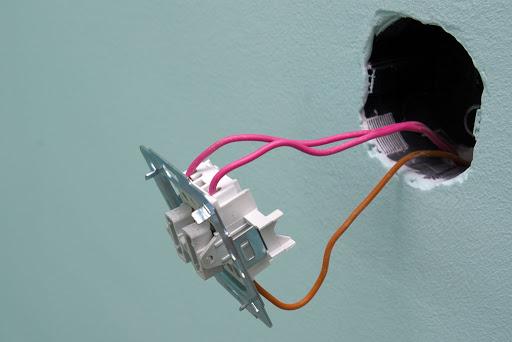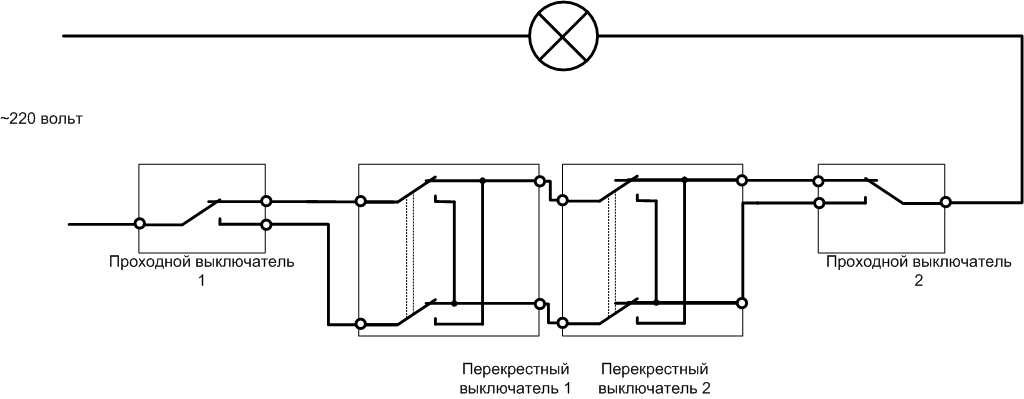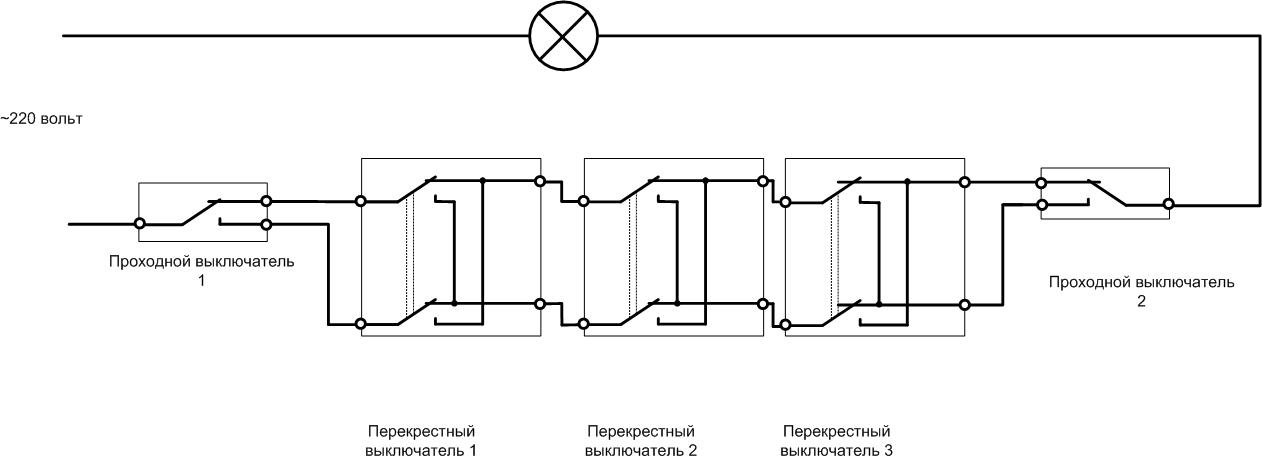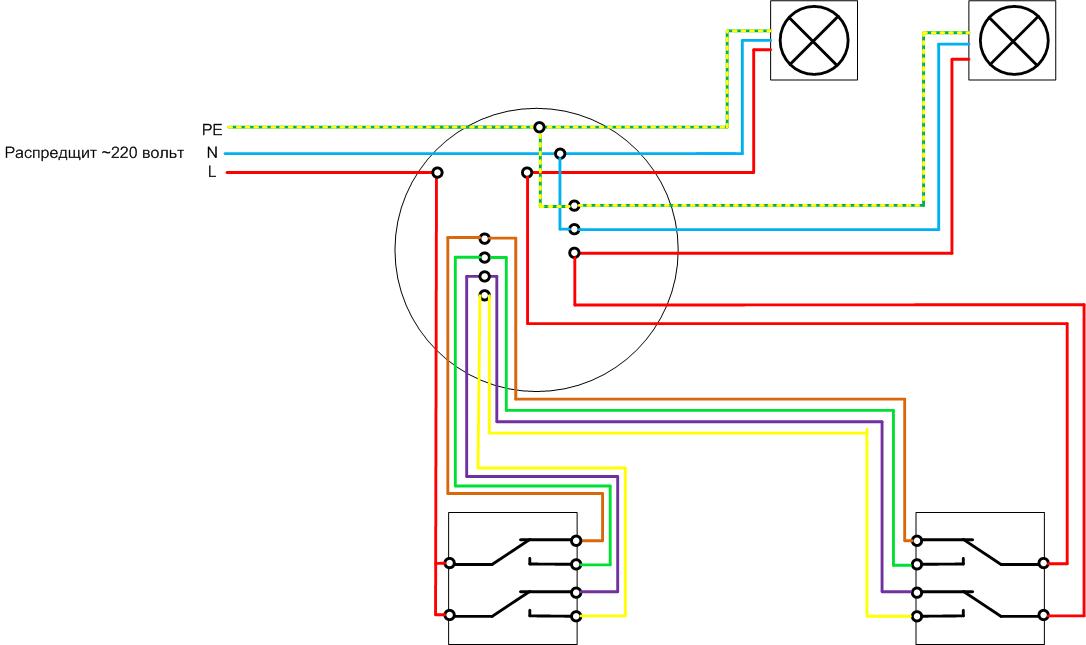How to wire a single push-button switch
On sale there are switches, in the technical documentation for which the name "pass-through". What is their peculiarity, how they differ from the usual, what is the scope of their application - about all of this below.
Sometimes in the management of lighting is required to turn on or off the light from two or more places. This situation may arise in rooms without the constant presence of people - long aisles or large areas with two or more exits. When you enter a corridor, you need to turn the light on, when you leave - off. Pass-through switches are designed and manufactured for this purpose - such a scheme is easy to build on them. Another example is Lighting in the stairways (flights of stairs). When you enter the house, you have to turn the light on, and when you go up to the desired floor - turn it off. That's why these fixtures are also called marching fixtures (and also duplicate or flip-flop fixtures).
In living rooms, such devices can be used in large rooms with several entrances, as well as in bedrooms. At the entrance to the bedroom you can turn on the light, and turn off the device next to the bed. On a similar principle, the lighting of children's rooms for one or more children - one switch at the entrance, the rest - near the bed of each child.

Advantages and disadvantages
The pros of the pass-through unit are evident when it is used in the area intended for it. With its help, you can create lighting control schemes, which can not be built on conventional devices. The disadvantages include only the impossibility of determining the state of the lights by the position of the key. And this disadvantage cannot be bypassed..
Principle of operation and the difference from the usual switch
What distinguishes the feed-through switch from a conventional switching device is that it has a specific contact group - with changeover contacts. Whereas a normal switch can only make or break an electric circuit, a feed-through switch can be alternately connected to one or the other line. Therefore, it is in fact a switch.
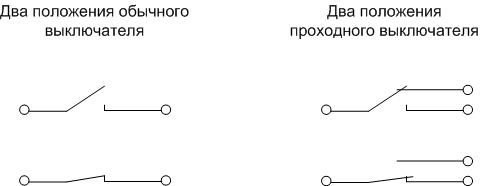
Walk-through devices are commercially available in single and two-key versions. In the first case, the scheme of the walk-through switch is standard - one key controls one contact group. In the second - two keys independently control each contact system. That is, two devices are placed in the same housing, not connected to each other electrically or mechanically.
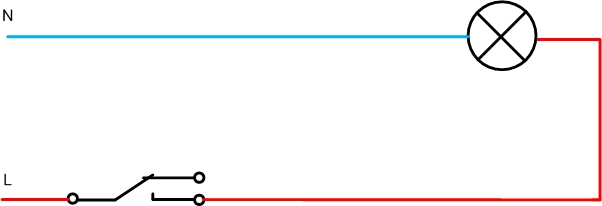
When examining the operation of the toggle contact system, we can conclude that the toggle switch can be used as a normal switch - using only two contacts (one movable and one stationary). This requires connecting to only two terminals. This kind of connection can be used if you don't have a normal switch handy. But it is not rational to intentionally do the installation of a flip-flop device instead of a standard one - its cost is higher.
It may be necessary to make a pass-through device yourself. The easiest option is to replace it with a two-key switch.
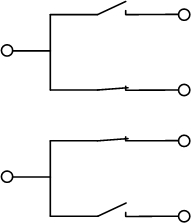
From the diagram, you can see that from such a device is easy to organize a flip-flop contact group. But there is a significant disadvantage: it is necessary to manipulate two keys, and you have to set them in opposite positions to each other. This is inconvenient and can lead to confusion. Switching on or off at the same time will not cause an accident - the contacts will simply duplicate each other. But it will not have the desired effect either.
In some two-key devices, the two contact groups are not combined.

In this variant you can try to turn one of the contact pairs by 180 degrees (if the design of the switch allows it). After that it remains only to connect the keys mechanically, so that it is possible to manipulate the contacts simultaneously (for example, by means of glue). You will get a full-fledged through-switch.
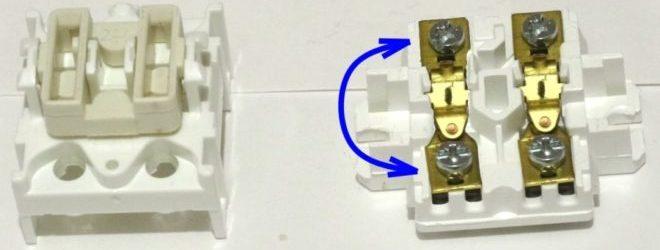

You can also build a makeshift transfer switch from an ordinary two-key switch with combined inputs, but this will require a serious modification of the contact group - trimming, rearrangement, etc. It is easier to buy a standard device or use a switch for production applications (a button with a locking position or toggle switch), sacrificing aesthetics.
We recommend that you read it: Design and principle of operation of a feed-through switch
Wiring diagrams
On the feed-through devices are assembled schemes of control of lighting devices so that the light can be switched on and off from two or more points with one manipulation, regardless of the position of the other switching elements.
Switching on lights from two places
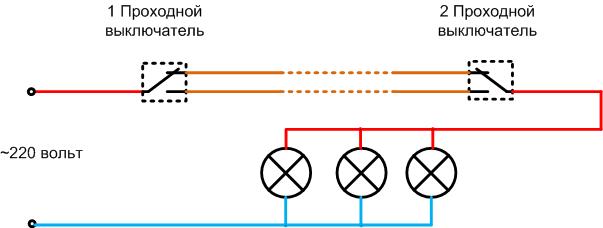
Two switches with changeover contacts will be needed to build a two-point light on/off circuit. You can see from the diagram that whichever position the first element is in, the second element can close and open the lamp power circuit.
If you use double switch, you can control two lights or groups of lights. For example, spot or general lighting of a room. Or instead of the second lamp you can connect another consumer (forced ventilation system, etc.).
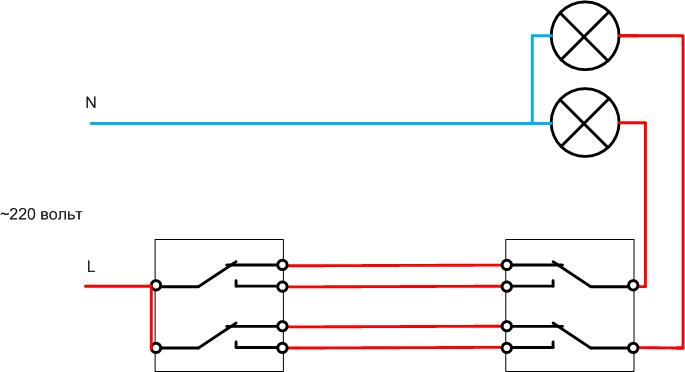
Control of luminaires from three points
In order to switch lights independently from three points, in addition to the flip-flop fixture, you will also need a cross-over fixture. Its key controls the contact group containing two flip pairs connected in a special way:
- each pair has its own separate input;
- the normally open contact of one pair connects to the normally closed contact of the other pair and connects to a common terminal;
- The normally closed contact of one pair connects to the normally open contact of the other pair and connects to the other common terminal.
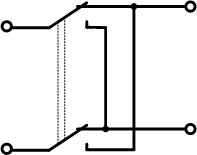
This device is also called a reversing device - it can be used to reverse the polarity of the DC voltage on the load, and reverse the direction of rotation of, for example, a DC motor.
Such a wiring diagram of pass-through and crossover switches will come in handy in T-aisles or in children's rooms for two.
Controlling lights from four locations
By adding one intermediate reversing device, you can control lights from four different locations.
The scheme seems cumbersome because of the abundance of contacts. But in fact, the switches are connected to each other with only two wires.
Independent light control from five locations
The same principle can be used to increase the number of on and off points for lighting fixtures to five.
Adding each intermediate reversing element increases the number of control points by one. Theoretically, the number of lamp points can be increased to infinity, just enough crossover switches are needed. In practice, it is rarely necessary to have even five control points.
How the switch is mounted
The installation of an electric light marching switch is fundamentally different from installation of an ordinary switching element does not have. Exactly the same will be required:
- choose the type of wiring (open or concealed);
- To outline the routes of laying cables;
- prepare channels (for exposed wiring) or install supporting insulators (trays) for exposed wiring;
- arrange installation locations for junction boxes and switchgear, install lighting fixtures;
- lay and fix cables, lead out the ends in sockets and distribution boxes (if installed);
- separate the ends of the conductors;
- Connect the corresponding wires to the terminals of the circuit breakers.
Important! Electrical installation regulations require a distance of at least 50 cm from the place of installation of switches to the gas pipes. For the rest, PUE contains only advisory information.
After that you can check the installation, apply voltage and test the lighting system.
Selecting a cable for lighting
The cross-section of the cables used for the installation of lighting systems should be chosen according to their economic current density and checked for their thermal and dynamic short-circuit current resistance. For implementation of networks of lighting for all parameters suitable copper products with a cross section of conductors 1.5 sq.mm. This has become a kind of standard for the installation of lighting wiring. A smaller cross-section, even if it meets the local selection criteria, does not provide mechanical strength. More leads to irrational expenditure of finances.
Although in Russia it is allowed to carry out wiring with cables with aluminum conductors, it is strongly recommended to use only products with copper conductors. Also, do not use conductor products with stranded conductors.
For the arrangement of wiring, depending on the selected scheme and topology, cables with a number of conductors from 2 to 4 may be required. Common types of cable products, suitable for work, are given in the table.
| Cable type | Cross section, sq. mm | Material | Number of veins | Additional Properties |
|---|---|---|---|---|
| VVG-Png(A) 2x1,5 | 1,5 | copper | 2 | Flat, non-flammable |
| VVG-NG(A) 2x1.5 | 2 | Non-combustible | ||
| NYY-J 2*1,5 | 2 | Non-combustible, low smoke | ||
| VVGP- 3x1,5 | 3 | Flat | ||
| VVG-NG- 3x1,5 | 3 | Non-combustible | ||
| CYKY 3x1,5 | 3 | Non-combustible | ||
| VVG-NG- 4x1,5 | 4 | Non-combustible | ||
| NYY-O 4x1.5 | 4 | Non-combustible |
Read in more detail in a separate article: What wire to choose for lighting wiring
Installing with a distribution box
For the installation of a lighting system with the use of marshalling devices can be used switch box. This choice has advantages:
- the connection takes place in one place;
- it is easy to check the correctness of the installation by means of a test run;
- In some cases the cable is saved;
- The installation is organized, it is easy to understand even to those who have not directly performed the connection.
Wiring schemes can vary, but the principles of installation remain the same:
- From the switchboard comes the supply cable with phase, neutral and protective conductor (L, N, PE respectively);
- conductors N и PE go in transit to consumers (if there are more than one load, they diverge to the corresponding number of branches);
- The phase conductor is disconnected, the cable that goes down to the switches is included in the gap, then it branches off and goes to the consumers.

As an example, the installation of the control circuit from three places (for a two-wire network, without a PE conductor) is shown. The disadvantages of this method are obvious:
- From the last switch in the scheme it is necessary to pull the cable back to the distribution box, this is not rational, since its length can be significant;
- for the lamp must be laid a separate cable, this is not always optimal.
Another disadvantage of using junction boxes appears in parallel complication of the circuit.
As an illustration, a circuit with two marshalling switches and one reversing switch is shown. The more complex the circuit, the more:
- With more cores, cables are required;
- more connections are made in the box, which leads to an increased probability of installation errors and requires the use of larger junction boxes.
Therefore, if possible, it is necessary to apply the cable routing as a daisy-chain. Although the decision on the topology of cable routes must be made individually, each time taking into account local conditions.
Safety measures for the operation of lighting networks
When When planning When planning and installing the lighting system, you must remember that the lighting system must be connected with a separate circuit breaker, which should be installed in the switchboard. For wiring with a core cross section of 1.5 mm², you must install a circuit breaker rated 10 A.
Another safety feature is the grounding of lighting fixtures. It is mandatory if there is a PE conductor. It is connected to the terminal of the lighting fixture marked with the letters PE or the ground symbol.
Possible connection errors
The main mistake made during installation of such switchgear is Incorrect identification of the switch terminals. Intuitively, the common contact is considered to be the terminal on the opposite side from the other two. This is not always true. Different manufacturers can arrange the contact system any way they want. Therefore, you should look at the markings, or better yet, call out the pin assignment with a multimeter.
The rest of the possible errors come down to improper installation. To minimize the likelihood of incorrect wiring, it is recommended to use cable products with marked cores (color or numbers).
Video tutorials: Wiring Diagrams and Errors of Walk-Through Switches.
The use of marching switches offers a wide range of possibilities for creating lighting control systems. But their use must be conscious. And you should start by drawing a diagram on paper. It is easier to find mistakes and cheaper to fix them. And only after the reconciliation of the scheme can you begin preparing for installation. Then success is guaranteed.
